British Asian
British Asians (also referred to as South Asians in the United Kingdom, Asian British people or Asian Britons) are persons of predominantly South Asian, East Asian and sometimes of broader Asian descent, who reside in the United Kingdom.[2] In British English usage, the term Asian usually refers to people who trace their ancestry to South Asia, in particular the former British Raj and Ceylon (the modern countries of India, Pakistan, Bangladesh, Myanmar, Sri Lanka and the Maldives).
| Total population | |
|---|---|
| Asian British – 4,373,339 (6.9%) (2011)[lower-alpha 1] of which | |
| Regions with significant populations | |
| 4,143,403 (7.8%) (2011) | |
| 140,678 (2.7%) (2011) | |
| 70,128 (2.3%) (2011) | |
| 19,130 (1.1%) (2011) | |
| Languages | |
| Religion | |
| Muslim (43.4%) Hindu (18.5%) Christian (10.9%) Sikh (8.7%) Irreligious (8.3%) Buddhist (3.5%) Zoroastrian, Jain, and Jewish minorities. Figures for England and Wales (2011) only.[1] | |
Since the 2001 census, British people of general Asian descent have been included in the "Asian/Asian British" grouping ("Asian, Asian Scottish or Asian British" grouping in Scotland) of the UK census questionnaires.[3] Categories for British Indians, British Pakistanis, British Bangladeshis, British Chinese and Other Asians have existed under an Asian British heading since the 2011 census.[4]
Immigration of small numbers of South Asians to England began with the arrival of the East India Company to the Indian subcontinent in the 17th century. Indians came to Britain, for educational or economic reasons, during the British Raj, with most returning to India after a few months or years,[5] and in greater numbers as the Indian independence movement led to the partition of 1947, eventually creating the separate countries of India, Pakistan and Bangladesh.
The most significant wave of Asian immigration to and settlement in the United Kingdom came following World War II, with the resumed control of Hong Kong, the breakup of the British Empire and the independence of Pakistan, India, Sri Lanka and later Bangladesh, especially during the 1950s and 1960s. An influx of Asian immigrants also took place following the expulsion or flight of Indian communities (then holders of British passports) from the newly independent Uganda, Kenya and Tanzania in the early 1970s.
Terminology
In Britain, the word "Asian" most frequently refers to people of South Asian ancestry (Pakistanis, Indians, Bangladeshis and Sri Lankans). This usage contrasts to that in the United States, where it is used primarily to refer to people of East Asian origin.[6][7] The British Sociological Association's guidelines on equality and diversity suggest that "South Asian" is more precise than "Asian", and that the latter should not be used where there is a risk of it conflating South Asians with people from elsewhere in Asia.[7]
Census
The 1991 United Kingdom census was the first to include a question on ethnicity (apart from in Northern Ireland, where the question was not asked until 2001). The question had tick-boxes for "Indian", "Pakistani" and "Bangladeshi". There was also a tick box, as well as a general "Any other ethnic group (please describe)" option for those not wishing to identify with any of the pre-set tick boxes. For the 2001 census, in England and Wales, "Indian", "Pakistani" and "Bangladeshi" and "Any other Asian background (please write in)" options were grouped under an "Asian or Asian British" heading, with appearing under a separate heading. In Scotland, all of these tick-boxes were grouped together under an "Asian, Asian Scottish or Asian British" heading, and in Northern Ireland no broad headings were used, just tick-boxes for each of the Asian groups.[8]
The 2011 census questionnaire was more consistent with regard to the grouping of Asian ethnicities, such that Indian, Pakistani, Bangladeshi, Chinese and any other Asian background options appeared under a broad "Asian/Asian British" ("Asian, Asian Scottish or Asian British" in Scotland) heading in all parts of the UK. Shown in order, as listed on the 2011 Census form, the five categories of Asian British are:[4]
- Asian / Asian British: Indian, a reference to the South Asian nation of India, and British Indians.
- Asian / Asian British: Pakistani, a reference to the South Asian nation of Pakistan, and British Pakistanis.
- Asian / Asian British: Bangladeshi, a reference to the South Asian nation of Bangladesh, and British Bangladeshis.
- Asian / Asian British: Chinese, a reference to the East Asian nation of China, and British Chinese people.
- Asian / Asian British: Other Asian, a broad description suitable for specifying self-identified ethnic descent from South Asian nations without an exclusive category (e.g. Sri Lanka and British Sri Lankans), the same application for other East Asian nations (e.g. Japan and British Japanese) and British people of Central Asian and Southeast Asian heritage.
Development in the 2010s
In the course of the 2010s, usage of British Asian broadened in British media usage and in self-identification by British citizens or residents, to increasingly also include British people of heritage other than South Asia, such as East Asia and West Asia. In the 2011 census, the two categories Chinese and Other Asian were listed explicitly under the broad heading and within the grouping of "Asian/Asian British".[4]
In 2013, BuzzFeed UK described J. K. Rowling's fictional character Cho Chang, which is named after a common Chinese surname, as a British Asian character.[9] In 2014, the BBC described British former professional boxer, and multiple featherweight world champion, Naseem Hamed as British Asian. Hamed, of West Asian descent, specifically Yemeni, was listed alongside fellow Briton Amir Kahn (of South Asian, Pakistani heritage) as part of the "strong boxing pedigree in the British Asian community".[10]
In 2016, The Herald detailed how The Print Room theatre had failed to cast Chinese characters (referred to as "British Asian") in an upcoming Howard Barker play set in ancient China. The Scottish newspaper reported that "Characters include Mrs Hu, Lord Ghang and Lady Hasi but no British Asian character has been cast."[11] The following year, the director of London-based company Yellow Earth Theatre, an organisation founded to promote and support actors, writers and directors of East Asian heritage, identified herself and the theatre's members as British Asian; "a great many wonderful, talented British Asian actors, but we get few enough roles as it is, because we're not seen as English".[12] Filipino-born British actress Lourdes Faberes, who was described by The Daily Telegraph as British Asian, starred in a parallel production ran by the Theatre company in order to promote and cast Asian actors.[13]
In 2019, British businesswoman Jacqueline de Rojas was recognised as one of 14 winners in the UK-based Asian Women of Achievement Award. de Rojas, who has Chinese heritage, was celebrated by organiser and founder of the awards, Pinky Lilani, who stated she was "truly proud of the positive impact these British-Asian women are making on the world today".[14] In the same year, BBC Asian Network's Brown Girls Do It Too radio programme featured three British podcasters, respectively of Bangladeshi, Iranian, and Indian descent, which The Guardian reported as "British Asian girls talking about masturbation and blowjobs on a BBC platform".[15] As quoted by HuffPost UK, presenter Roya Eslami, within the context of her West Asian heritage, specifically self-identified as British Asian.[16]
In 2020, Gemma Chan was described by the BBC as a British Asian actor.[17] With both parents born in China, Chan also self-identifies as British Asian.[18][19] As reported in British Vogue, she has referred to British businesswoman Sandra Choi, who is also of East Asian heritage, and is the creative director of British high fashion house Jimmy Choo Ltd, as a British Asian designer.[20]
Demographics
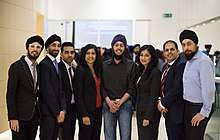
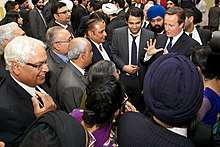
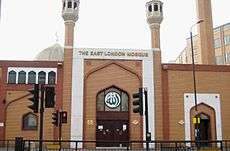
The 2011 United Kingdom census recorded 1,451,862 residents of Indian, 1,174,983 of Pakistani, 451,529 of Bangladeshi, 433,150 of Chinese, and 861,815 of "Other Asian" ethnicity, making a total Asian British population of 4,373,339 (6.9 per cent of the total population), excluding people of mixed ethnicity.[22] Due to a growing sense of affiliation with Britain, many third generation South Asians chose to not mark "Asian or British Asian" and instead marked "British Asian" in the "Other Asian" write in section.[23]
South Asian ethnic groups mostly originate from a few select places in South Asia, these are known as place of origins. East Asian ethnic groups are particularly represented by the Han Chinese in the United Kingdom. British Indians tend to originate mainly from the two Indian States, Punjab and Gujarat.[24] Evidence from Bradford and Birmingham have shown, Pakistanis originate largely from the Mirpur District in Azad Kashmir. The second largest ethnic group of British Pakistanis are the Punjabi people, largely from Attock District of Punjab followed by Pashtuns and other ethnic groups from the districts of Nowshera, Peshawar and Ghazi in province of Khyber Pakhtunkhwa. In the London Borough of Waltham Forest there are substantial numbers of Pakistani people originating from Jhelum, Punjab.[25] Studies have shown 95 per cent of British Bangladeshis originate from the Sylhet Division, located in the Northeastern part of Bangladesh. British Chinese people originate primarily from former British colonies, such as Hong Kong, but also from areas of Southeast Asia, where they were already diasporic populations.[26][27]
There have been three waves of migration of Hindus in the United Kingdom. The first wave was before India's independence in 1947. In the early 1950s the Conservative Health Minister, Enoch Powell recruited a large number of doctors from the Indian sub-continent. The second wave occurred in the 1970s mainly from East Africa. The later communities included those from Guyana, Trinidad and Tobago, Mauritius and Fiji. The last wave of migration began in the 1990s and included Tamil refugees from Sri Lanka and professionals including doctors and software engineers from India.
Employment
The unemployment rate among Indian men was only slightly higher than that for White British or White Irish men, 7 per cent compared with 5 per cent for the other two groups. On the other hand, Pakistanis have higher unemployment rates of 13–14%, and Bangladeshis have one of the highest rates, around 23%.[28] Some surveys also revealed the Indian unemployment rate to be 6–7%[29] Persons of Indian or mixed Indian origin are more likely than White British to have university degrees, whereas Pakistanis and Bangladeshis are less likely.[30] With the exception of Bangladeshi women, every other group of South Asians, have higher attendance at university than the national average.[31] GCSE pass rates have been rising for all South Asians.[32]
In the UK South Asian population has higher rates of unemployment compared to the White-British population, and number of 16 to 64 year old's who were employed, by ethnicity showed Indians overall had the same ratio in employment as White-British at 76%. However those from Pakistani, Bangladeshi backgrounds have far lower rates in employment at 57%. The gap between men and women was biggest in the combined Pakistani and Bangladeshi ethnic group, where 75% of men and 39% of women were employed compared to 80% of men and 73% of women amongst White-British.[33]
As of 2020, citizens of India and the Philippines are the largest foreign-national groups of National Health Service workers.[34]
Language
Chinese Britons speak the Mandarin, Cantonese, Min, and Hakka languages. The language spoken by Indians are, Punjabi, Gujarati, Kutchi, Hindustani, Bengali, Tamil, Telugu and Malayalam. People from Pakistan speak Urdu, Punjabi, Mirpuri, Hindko (dialects of Punjabi), Sindhi, Kashmiri, Pashto and Saraiki. Gujaratis who emigrated from India and East Africa speak Gujarati, Hindi, and Kutchi (a dialect of Sindhi), while a sizeable number of Gujarati Muslims speak Urdu for religious and cultural reasons.[35] Bangladeshis speak Sylheti and Bengali. People from Sri Lanka speak Tamil and Sinhala. Those who speak dialects mainly refer their language to the main language, for example Sylheti speakers say they speak Bengali or Mirpuri speakers say they speak Punjabi. The reason for this is because they do not expect outsiders to be well informed about dialects.[36]
Religion
Asian Britons have significant numbers of adherents to various major religions. Based on 2011 census figures for England and Wales (94.7 percent of UK statistics), Muslims account for 43% of the group, while Hindus make up over 18%, and Christians almost 11%. Sikhs constitute nearly 9% of British Asians, and 3.5% are Buddhists.[1]
British Chinese are mainly irreligious, with 55% of the population subscribing to no religion, 19% Christians and 12% Buddhists. British Pakistanis and Bangladeshis tend to be religiously homogeneous, with Muslims accounting for 92% of each group while their counterparts of Indian and Sri Lankan origin are more religiously diverse, with 55% Hindus, 29% Sikhs, and 15% Muslims. British Gujaratis are predominantly Hindu, belonging to various caste organizations, with large minorities of Muslims, Jains, and smaller numbers of Christians and Zoroastrians. Notable religious buildings are the East London Mosque, London Central Mosque, Birmingham Central Mosque, Baitul Futuh Mosque, BAPS Shri Swaminarayan Mandir London, Bradford Lakshmi Narayan Hindu Temple, Shikharbandi Jain Derasar in Potters Bar,[37] Gurdwara Sri Guru Singh Sabha in Southall and Guru Nanak Darbar Gurdwara in Gravesend.
The publication of Salman Rushdie's novel The Satanic Verses in 1988 caused major controversy. Muslims condemned the book for blasphemy. On 2 December 1988 the book was publicly burned at a demonstration in Bolton attended by 7,000 Muslims, followed by a similar demonstration and book-burning in Bradford on 14 January 1989.[38] In 1989 Ayatollah Ruhollah Khomeini of Iran issued a fatwa ordering Muslims to kill Rushdie.[39]
Britain is also home of notable Asian religious leaders and scholars. Some of them are Mirza Masroor Ahmad (Caliph of the Ahmadiyya Community), Sheikh Abdul Qayum (one of the best known scholars in Europe and Chief Imam of East London Mosque), Abu Yusuf Riyadh ul Haq (Khateeb of Birmingham Central Mosque), Dr. Mahmudul Hasan (Khateeb of Essex Mosque), Abdur Rahman Madani (Chairman of Global Eid Trust and Chief Imam of Darul Ummah Mosque), Faiz-ul-Aqtab Siddiqi (principal of Hijaz College), Ajmal Masroor (Imam and Liberal Democrats politician) and Pramukh Swami Maharaj (fifth spiritual successor of Hindu Swaminarayan).
History in Britain
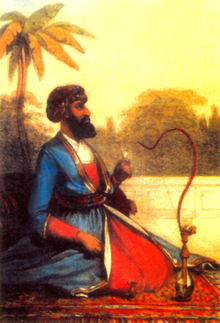

The earliest date at which South Asians settled in Great Britain is not clear.
If the Romany (Gypsies) are included, then the earliest arrivals were in the Middle Ages. DNA surveys have linked Romanies to present-day South Asian populations and the Romani language is a member of the Indo-Aryan language family. Romanies are believed to have begun travelling westward around 1000 CE, and have mixed with Southwest Asian and European populations over many centuries. Romani began arriving in sizeable numbers in parts of Western Europe in the 16th century. The Romani who settled in Britain are known as Romanichal.
The first educated South Asian to travel to Europe and live in Britain was I'tisam-ud-Din, a Bengali Muslim cleric, munshi and diplomat to the Mughal Empire who arrived in 1765 with his servant Muhammad Muqim during the reign of George III.[40] He wrote of his experiences and travels in his Persian book, Shigurf-nama-i-Wilayat ('Wonderous Chronicle of Europe').[41] This is also the earliest record of literature by a British Asian. Also during the reign of George III, the hookah-bardar (hookah servant/preparer) of James Achilles Kirkpatrick was said to have robbed and cheated Kirkpatrick, making his way to England and stylising himself as the Prince of Sylhet. The man, presumably of Sylheti origin, was waited upon by the Prime Minister of Great Britain William Pitt the Younger, and then dined with the Duke of York before presenting himself in front of the King.[42]
Lascar
When the Portuguese Vasco da Gama arrived in India in 1498, he opened a direct maritime route between South Asia and Europe. In the following century many South Asians arrived in Europe by sea as sailors, slaves and servants. Trade and English piracy brought some of these people to Britain and four South Asian men in London answered the call for sailors for the first English East India Company fleet to Asia. Their Portuguese names identifies them as mixed-race Portuguese Luso-Asians.[43]
Since the 17th century, the East India Company employed thousands of South Asian lascars, scholars and workers (who were mostly Bengali or Muslim) mainly to work on British ships and ports around the world. The first group of South Asians to migrate in notable numbers, in the 18th century, were lascars (sailors) recruited from the Indian subcontinent (largely from the Bengal region) to work for the British East India Company, some, despite prejudice and a language barrier, settled down, often forcibly after ill treatment and being abandoned by ship masters. Many were forced into poverty and starved.[44][45] Letters to newspapers in 1785 talked of "the number of miserable objects, Lascars, … shivering and starving in the streets".[46] Some lascars took British wives, and some converted to Anglican Christianity (at least nominally) in order to marry,[47] possibly due to a lack of South Asian women in Britain at the time.[48] Most Indians during this period would visit or reside in Britain temporarily, returning to India after months or several years, bringing back knowledge about Britain in the process.[49]
38 lascars were reported arriving in British ports in 1760.[50][51] Between 1803 and 1813, there were more than 10,000 lascars from the Indian subcontinent visiting British port cities and towns.[52]:140, 154–6, 160–8, 172 By 1842, 3,000 lascars visited the UK annually, and by 1855, 12,000 lascars were arriving annually in British ports. In 1873, 3,271 lascars arrived in Britain.[53]:35 Throughout the early 19th century lascars visited Britain at a rate of 1,000 every year,[52]:140,54–6,60–8,72 which increased to a rate of 10,000 to 12,000 every year throughout the late 19th century.[54][55]
Due to the majority being lascars, the earliest Muslim communities were found in port towns, found living in barracks, Christian charity homes and hostels.[45] The first and most frequent South Asian travelers to Britain were Christian Indians and those of European-Asian mixed race. For Muslim Indians considerations about how their dietary and religious practices would alienate them from British society were brought into question but these considerations were often outweighed by economic opportunities. Those that stayed often took British names, dress and diet.[56] Naval cooks also came, many of them from the Sylhet Division of what is now Bangladesh. One of the most famous early Bengali Muslim immigrants to England was Sake Dean Mahomed, a captain of the British East India Company who in 1810 founded London's first Indian restaurant, the Hindoostane Coffee House. He is also reputed for introducing shampoo and therapeutic massage to the United Kingdom.[57] In 1784 he migrated to Ireland where he fell in love with a woman called Jane Daly. He converted to Anglicanism in order to marry her, as it was illegal at the time for non-Protestants to marry Protestants. They later moved to Brighton.[58]
After reports of lascars starving and suffering from poverty the East India Company responded by making available lodgings for them, but no checks were kept on the boarding houses and barracks they provided. The Lascars were made to live in cramped, dreadful conditions which resulted in the deaths of many each year, with reports of Lascars being locked in cupboards and whipped for misbehavior (by owners) which was reported by the Society for the Protection of Asiatic Sailors (founded in 1814).[46]
In 1842, the Church Missionary Society reported on the dire ″state of the Lascars in London″[59] it was reported in the winter of 1850, 40 Asian men, also known as 'sons of India', were found dead of cold and hunger on the streets of London. Shortly after these reports evangelical Christians proposed the construction of a charity house and gathered £15,000 pounds in assistance of the Lascars . In 1856 the Strangers' Home for Asiatics, Africans and South Sea Islanders was opened in Commercial Road, Limehouse under the manager Lieutenant-Colonel R. Marsh Hughes.[60]
The Navigation Act of 1660 restricted the employment of non-English sailors to a quarter of the crew on returning East India Company ships. Baptism records in East Greenwich suggest that young Indians from the Malabar Coast were being recruited as servants at the end of the 17th century, and records of the EIC also suggest that Indo-Portuguese cooks from Goa were retained by captains from voyage to voyage.[44] In 1797, 13 were buried in the parish of St Nicholas at Deptford.
It is estimated 8,000 Indians (a large proportion being lascar sailors) lived in Britain permanently prior to the 1950s. Although, the comparatively few lascars that gained work often opened shops and helped initiate social and political community associations.[61] Indians were less likely to settle permanently because of wage differentials.[62][63] Due to the majority of early South Asian immigrants being lascars, the earliest South Asian communities were found in port towns
The small, often transitory presence of Lascars continued into the 1930s, with the Port of London Authority mentioning Lascars in a February 1931 article writing that "Although appearing so out of place in the East End, they are well able to look after themselves, being regular seamen who came to the Docks time after time and have learnt a little English and know how to buy what they want."[64]
In 1932, the Indian National Congress survey of 'all Indians outside India' estimated that there were 7,128 Indians in the United Kingdom.[65] It is estimated that from 1800 to 1945, 20,000 South Asians emigrated to Britain.[66]
Post–World War II migration
Following the Second World War and the breakup of the British Empire, South Asian migration to the UK increased through the 1950s and 1960s from Pakistan (including present-day Bangladesh), India and Sri Lanka (who are all members of the Commonwealth). Additionally immigrants from former Caribbean colonies (including Indo-Caribbeans) were also moving to Britain.
Although this immigration was continuous, several distinct phases can be identified:
- Manual workers, mainly from Pakistan, were recruited to fulfill the labour shortage that resulted from World War II. These included Anglo-Indians who were recruited to work on the railways as they had done in India.
- Workers mainly from the Punjab region of India and Pakistan arrived in the late 1950s and 1960s. Many worked in the foundries of the English Midlands and a large number worked at Heathrow Airport in west London. This created an environment to where the next generation of families did not lose their identity as easily. An example would be Southall which is populated by many Sikhs.
- During the same time, medical staff from the Indian subcontinent were recruited for the newly formed National Health Service. These people were targeted as the British had established medical schools in the Indian subcontinent which conformed to the British standards of medical training.
Bengali social reformer and founder of the All-India Seamen's Federation, Aftab Ali's work is recognised to have helped thousands of Asian lascars to migrate, settle and find employment in Britain.[67] He organised rallies and meetings with the likes of the Trades Union Congress. He encouraged lascars and seamen to remain and settle in the United Kingdom. In the 1950s, he founded the Overseas Seamen's Welfare Association which campaigned distressed seamen and their families to be granted British passports. Ali also played an instrumental role in the opening of a passport office in his own home in Sylhet.[68]
Asian migration from East Africa
Beginning around 1964 Africanization policies in East Africa prompted the arrival of Asians with British passports from Kenya, Uganda and Tanzania. At first these were the people employed in government and administrative roles, but this was expanded to include those Asians engaged in commerce. The movement was called the "Exodus".[69]
In 1972, all South Asians were expelled from Uganda by the controversial figure Idi Amin, then president of Uganda. Those holding British passports came to Britain. Many such displaced people who were predominantly of Gujarati origins had left behind successful businesses and vast commercial empires in Uganda, but built up their lives all over again in Britain, starting from scratch. Some of these "twice-over" migrants became retailers, while others found suitable employment in white-collar professions.
The Commonwealth Immigrants Act 1962 and Immigration Act 1971 largely restricted any further primary immigration, although family members of already-settled migrants were still allowed. In addition, much of the subsequent growth in the South Asian community has come from the births of second and third-generation South Asian Britons.
Notable contributions
Arts and entertainment
Several Asian Britons have broken into the UK film industry, as well as Hollywood, and the U.S. film industry at large; starring in high-grossing box office films, including major film series, and receiving subsequent international recognition and media attention. In television, prominent roles in American sitcoms, series, and long-running British soap operas, such as Coronation Street, EastEnders, Emmerdale and Hollyoaks, have all had a number of Asian characters portrayed by British actors of Asian heritage.
Tsai Chin, the first Asian British actress to play a Bond girl, appeared in 1967's You Only Live Twice and the 2006 re-make of Casino Royale.[70] Burt Kwouk, who appeared in over fifty films, including three of the James Bond film series, received an OBE for services to drama in 2010.[71] Art Malik had notable roles in The Jewel in the Crown and The Living Daylights, and Sir Ben Kingsley (born Krishna Pandit Bhanji) is one of Britain's most acclaimed and well-known performers. Kingsley is one of few actors to have won all four major motion picture acting awards, receiving Oscar, BAFTA, Golden Globe and Screen Actors Guild awards throughout his career, including the Academy Award for Best Actor for his performance in Gandhi (1982).[72]
The actor Dev Patel, who played the role of Anwar Kharral in the teen drama series Skins, portrayed the leading role in Danny Boyle's Slumdog Millionaire, for which he received several awards and was nominated for the 2009 BAFTA Award for Best Leading Actor.[73] Parminder Nagra, who played a prominent role in the US TV series ER, starred in successful British film Bend It Like Beckham (2002). The actor Naveen Andrews plays the role of Sayid Jarrah in the popular US TV series Lost, and also had a prominent role in the award-winning film The English Patient (1996). Kunal Nayyar plays the character of Raj Koothrappali in the popular US sitcom, The Big Bang Theory.
Gemma Chan and Benedict Wong have featured in the Marvel Cinematic Universe franchise. Chan has had two starring roles in both 2019's Captain Marvel and The Eternals (2021), making her the first actress to portray separate characters within the cinematic universe.[74] Wong, who has also appeared in two Ridley Scott films (Prometheus and The Martian), first appeared for a Marvel production in 2016's Doctor Strange, twice reprising the role for Avengers: Infinity War (2018) and Endgame (2019), the latter of which is the highest grossing release in film history.[75] Riz Ahmed has starred in both the Bourne film series and Star Wars saga, appearing in anthology film Rogue One.[76] Star Wars, Marvel's The Avengers, the Bourne and James Bond film series are some of the highest-grossing film franchises of all time.[77]
Art and design
.jpg)
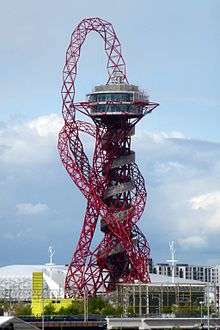
Anish Kapoor is an Indian-born British sculptor. Born in Mumbai, Kapoor has lived and worked in London since the early 1970s when he moved to study art, first at the Hornsey College of Art and later at the Chelsea College of Art and Design. Kapoor received the Turner Prize in 1991. Born in London and of Asian origin, Shezad Dawood became known for this work in various media in the early 2000s. Also born in London and of Pakistani origin, Haroon Mirza emerged as an artist in the late 2000s. Best known for his sculptural installations that generate sound, Mirza was awarded the Silver Lion for the Most Promising Artist at the 54th Venice Biennale in 2011.
Shahidul Alam is a Bangladeshi photojournalist, teacher and social activist. He has been a photographer for more than forty years and "his photographs have been published in almost every major western media outlet".[78] Saiman Miah is an architectural designer and graphic designer who designed one of the two £5 commemorative coins for the 2012 London Summer Olympics.[79]
Theatre company RIFCO Arts has been producing and touring productions based on the British Asian experience since 1999.[80]
Literature
Well-known South Asian writers include Muhammad Mojlum Khan, Abdur Rouf Choudhury, Aminul Hoque, Shahida Rahman, H.S. Bhabra, Salman Rushdie, Ghulam Murshid, Tahir Shah, Gurinder Chadha, Nazrin Choudhury, Rekha Waheed, Hanif Kureshi, Monica Ali, Meera Syal, Gautam Malkani, Bali Rai and Raman Mundair.
Music
Since the 1970s, South Asian performers and writers have achieved significant mainstream cultural success. The first South Asian musician to gain wide popularity in the UK and worldwide fame was Queen lead singer Freddie Mercury, born Farrokh Bulsara in Zanzibar, East Africa, to parents of Parsi descent from Bombay (now Mumbai). In 2006, Time Asia magazine voted him as one of the most influential South Asians in the past 60 years.[81] At around the same time, music producer, composer and songwriter Biddu gained worldwide fame for a number of hit songs, including "Kung Fu Fighting" by Carl Douglas and "I Love to Love (But My Baby Loves to Dance)" for Tina Charles. In the 1990s the South Asian artists who gained mainstream success included Apache Indian, whose 1993 single "Boom Shack-A-Lak" was used in many Hollywood movies, and Jas Mann, who headed Babylon Zoo and whose 1996 single "Spaceman" set a UK chart record when it sold 418,000 copies in its first week of release. The most successful South Asian musician in 2008 was the British Tamil artist M.I.A., who was nominated for two Grammy Awards for her single "Paper Planes", and has been nominated for an Academy Award for Best Original Score for "O... Saya", from the Slumdog Millionaire soundtrack.
In 2009, R&B and hip-hop artist, Mumzy Stranger, became the first British Bangladeshi to release a music single; titled "One More Dance".[82] In October 2009, Jay Sean's single "Down" reached the #1 on the Billboard Hot 100[83] and sold four million copies in the United States,[84][85] making him the first South Asian-origin solo artist and "the first UK Urban act to top Billboard's Hot 100,"[86] "the most successful male UK urban artist in US chart history,"[87] and the most successful British male artist in the US charts since Elton John in 1997. A new generation of British Asian musicians have followed such as Raxstar, Bilal and Nish. In the early 2010s, Asian boy band members, Siva Kaneswaran of the Wanted and Zayn Malik of One Direction, have gained considerable mainstream popularity worldwide; the Wanted reached No. 3 on the Billboard Hot 100 with "Glad You Came" while One Direction topped the Billboard 200 with Up All Night. British Bangladeshi youtuber-turned-rapper Koomz is best known for his breakthrough single "Mariah" which has hit over 10 million streams and views across many platforms and also Number 1 in the Official Asian Music Chart of 2018.[88][89]
Charity and interfaith
There is a growing number of young British Asians who are making a mark in the charity and interfaith sectors. A recent example is Onkardeep Singh who became the youngest person of South Asian heritage in 2018 to be awarded an MBE for his interfaith and voluntary works.[90] Saif Uddin Ahmad is a humanitarian and Chief Executive Officer of Al-Khair Foundation. He was formerly the chief executive officer of the UK charities Muslim Aid and Islamic Help, and he also founded the charities Faith Regen foundation, MADE in Europe and Global One 2015.[91] Responsible investment consultant and writer, Niaz Alam was a trustee of the charity War on Want from 2000 to 2007.[92]
Sports
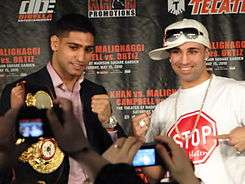
Jawaid Khaliq, the first world champion boxer of Pakistani origin, was born in Nottingham. Amir Khan, the silver medallist at the 2004 Summer Olympics in Athens, has become a cultural icon in the UK with TV audiences of up to 8 million watching him fight. Khan represents Britain in boxing and is the former WBA world light welterweight champion.
Michael Chopra played for the England national under-21 football team and became the first footballer of Indian descent to play and score in the Premier League. In 2006 he scored one of the fastest goals in Premier League history, as Chopra had only been on the pitch for fifteen seconds after coming on as a substitute.[93] Aston Villa defender, Neil Taylor is also of Indian descent. Currently in the Premier League, Hamza Choudhury, a footballer of Bangladeshi descent, plays for Leicester City F.C., making him the first player of Bangladeshi descent to play in the Premier League, and has also made appearances for the England under-21 team.
Just as in South Asia, the most popular sport among the British Asian community is cricket; as much as third of the players of the sport at recreational level are of South Asian descent.[94] This has not translated into equal levels of success professionally however, with only 4.2% of cricketers being of British South Asian descent in first-class cricket across the UK.[94] Regardless, many British South Asians have gone on to represent England in cricket internationally. Nasser Hussain, who was the captain of the England cricket team, was born in Madras, India.[95] Other success stories of the past have included Mark Ramprakash, of Indo-Caribbean descent, Isa Guha, of Bengali descent, and Monty Panesar, of Indian Sikh descent. Currently, Moeen Ali and Adil Rashid are the only players in the England men's squad, both of Pakistani (Mipuri) descent. Ali, affectionately known by fans as 'the beard's that's feared', is currently ranked the 7th best all-rounder in ODI cricket and 8th-best in test cricket worldwide.[96]
Other British Asian sport personalities:
Celebrities in popular culture
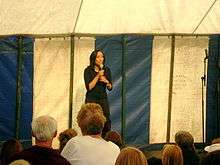
The comedians Sanjeev Bhaskar, Meera Syal, Papa CJ and Shazia Mirza are all well-recognised figures in British popular culture. The presenter and match maker of the BBC marriage arranging show Arrange Me a Marriage is a South Asian-Scot Aneela Rahman. Hardeep Singh Kohli is a presenter, reporter and comedian on British television and radio. British Bangladeshi, Pakistani and Indian contestants have appeared on The Apprentice including Syed Ahmed, Tre Azam, Lohit Kalburgi, Ghazal Asif, Shazia Wahab, Sara Dhada, and most notably Saira Khan, who is now a British TV presenter. The broadcasters Daljit Dhaliwal, Krishnan Guru-Murthy and Samira Ahmed are known for working on Channel 4 News.
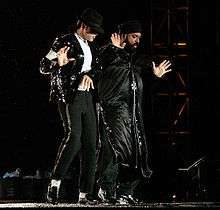
In 2008, in the second series of reality television Britain's Got Talent, one of the country's most successful reality television shows, the South Asian dance duo Signature, consisting of Suleman Mirza (a British Pakistani) and Madhu Singh (a British Indian) performing a fusion of Michael Jackson and Bhangra music and dance styles, came second on the show.
Humza Arshad and Ali Shahalom are well known British Asian comedians for their YouTube careers which normally consists of stereotyping Pakistani, Bangladeshi and Muslim culture. In 2011, one of Humza Arshad's video was the seventh most viewed on YouTube in Europe.[97][98] British Bangladeshi comedian Ali Shahalom, along with British Pakistani comedian Aatif Nawaz, starred on BBC's first ever British Muslim sketch show, Muzlamic.
Cultural influence
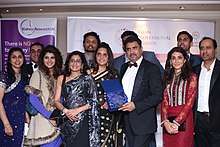
Economic
In 2001, the Centre for Social Markets estimated that British Asian businesses contributed more than £5 billion to GDP.[99] Many British Asians are regarded as affluent middle-class people.[100][101] As business owners and entrepreneurs,[102] Asian Britons are celebrated for revolutionising the corner shop, expanding the take-away food trade,[103] including the revitalisation of the UK's fish and chips industry by British Chinese,[104] and energising the British economy to a degree which changed Britain's antiquated retail laws forever.[105][106][107] In 2004, it was reported that Sikhs had the highest percentage of home ownership in the country, at 82%, out of all UK religious communities. Hindus ranked third highest at 74%, Buddhists were 54%, and Muslims households were listed at 52%.[108]
Many Asian British people have made important contributions to the country's economy by leading and innovating in major UK and international industries. Due to ther commercial success, there are a number of British citizen or UK-resident billionaires of Asian ancestry in the United Kingdom. From a Baniya family, Lakshmi Mittal is one of Britain's richest men. In 2017, Forbes ranked him as the 56th-richest person in the world with a net worth of US$20.4 billion. He is also the "57th-most powerful person" of the 72 individuals named in Forbes' "Most Powerful People" list for 2015.[109] The Sunday Times Rich List has included Mittal in its listings since the mid-2000s.
For several years, the publication has had an Asian Rich List section, featuring the wealthiest Asian Britons and UK-residents of Asian descent. In 2019, eight of the top ten, including Mittal, were of a South Asian ethnic background, including Indian-born Briton S. P. Hinduja, of Sindhi heritage, who topped the rankings via the Hinduja Group, with an estimated fortune of £22 billion.[110] Exceptions included British nationals David and Simon Reuben, who were both born in India, and were listed in joint-second place. The Reuben brothers, of West Asian Baghdadi Jewish heritage, are worth over £18 billion. Part of the top ten since 2018, property magnate, and London-resident, Samuel Tak Lee is of East Asian descent and born in British Hong Kong.[111] Other 2019 Asian Rich List UK billionaires included British-Iraqi Nadhmi Auchi and British-Iranian Farhad Moshiri.[110]
Food
The biggest influence of South Asians on popular British culture has probably been the spread of Indian cuisine, though of the 9,000 Indian restaurants in the UK, most are run by Sylhetis; their ancestral home was part of British India until partition in 1947.
An early record of a Sylheti migrant, by the name of Saeed Ullah, can be found in colonial officer Robert Lindsay's autobiography. Saeed Ullah was said to have migrated not only for work but also to attack Lindsay and avenge his Sylheti elders for the Muharram Rebellion of 1782.[112] They eventually made peace with each other and Saeed was invited to Lindsay's home as a chef. Saeed Ullah's curry is often considered as the first Indian curry cooked in Britain.[113][114]
Shah Abdul Majid Qureshi is said to be the first Sylheti to open a restaurant in the country. It was called Dilkush Delight and located in Soho.[115] Another one of his restaurants, known as India Centre, alongside early Sylheti migrant Ayub Ali Master's Shah Jalal cafe, became hub for the British Asian community and was sites where the India League would hold meetings attracting influential figures such as Subhas Chandra Bose, Krishna Menon and Mulk Raj Anand. Ali was an influential figure who supported working-class lascars, providing them food and shelter. In 1943, Qureshi and Ali founded the Indian Seamen's Welfare League which ensured social welfare for British Asians. Ayub Ali was also the president of the United Kingdom Muslim League having links with Liaquat Ali Khan and Muhammad Ali Jinnah.[116]
The Indian International Chef of the Year Competition founded in 1991 by celebrity chef and restaurateur Mohammad Ajman "Tommy" Miah MBE.[117] The British Curry Awards was founded by restaurateur Enam Ali MBE in 2005.[118]
Performing arts
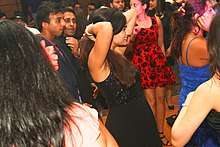
As in Canada, Bhangra music has become popular among many in Britain[119] not only from the works of British South Asian musicians such as Panjabi MC, Swami and Rishi Rich but also incorporated into the works of a number of non-South Asian musicians not only British but including North American artists such as Canadian Shania Twain, who created a whole alternate version of her multi-platinum album Up! with full Indian instrumentation, produced by South Asian producers Simon & Diamond. Diamond, better known as DJ Swami has also collaborated with rapper Pras, of the Fugees, and his band Swami have become one of the most renowned acts in South Asian music history, having had songs in major Hollywood movies and best-selling video games.
One of the first artists of South Asian Indian origin to achieve mainstream success was Apache Indian who infused reggae and hip hop with Indian popular music to create a sound that transcended genre and found a multicultural audience. He is the only Indian artist to have achieved 7 top forty hits in the National UK charts. A subsequent wave of "Asian Underground" artists went on to blend elements of western underground dance music and the traditional music of their home countries, such as Nitin Sawhney, Talvin Singh, Asian Dub Foundation, Panjabi MC, Raghav, and the Rishi Rich Project (featuring Rishi Rich, Jay Sean and Juggy D).
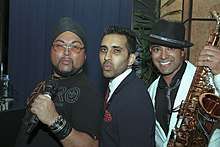
The influence of South Asian music has not only been from South Asians living in the UK, but also from some UK artists that were starting using South Asian instruments creating a new sound that was a mixture of sitars and tablas with more rock-based western instruments like drums and guitar.[120][121]
Media
The films East Is East, Chicken Tikka Masala and Bend It Like Beckham and the TV shows Goodness Gracious Me and The Kumars at No. 42 have managed to attract large, multi-ethnic audiences. The success and popularity of British Pakistani boxer Amir Khan influenced the revival of boxing on ITV Sport.
The Asian web series Corner Shop Show was launched by actor and director Islah Abdur-Rahman aired from 2014 to 2019.[122]
In 2020, BBC Four released an episode of A Very British History focusing on the history of British Bangladeshis and emigration from Bangladesh from the 1960s onwards, hosted by Dr Aminul Hoque.[123]
Although there are roughly double the number of South Asians in the UK today compared to people of African descent, South Asians are less represented in global and British media than any other major group; in the UK there is less than half the amount of South Asians represented in the media than those of African and Caribbean descent.
Awards and achievements
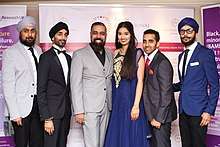
With the increasing number of high achievers and trail blazers within the Asian community across a variety of professions, the British Asian community has over the years set up a variety of high-profile Award ceremonies to recognise Asian achievements across the full spectrum of professions and industries. These organisations and ceremonies include:
- Asian Achievers Awards organised by Asian Voice since 2000 with women dominating the nominee list for the first time in 2017 [124]
- Asian Women of Achievement Awards organised by Pinky Lilani CBE DL since 1999 [125]
- Asian Legal Awards organised by the Society for Asian Lawyers since 1994 making it one of the oldest Asian awards ceremonies [126]
- Asian Curry Awards celebrating the best of Asian restaurants since 2010
- The Asian Awards organised by the Lemon Group since 2010 and usually attended by a host of leading celebrities [127]
- The Asian Professional Awards organised by Jasvir Singh OBE and Param Singh since 2014 aimed at celebrating success within the City professions [128]
- The British Curry Awards founded by restaurateur Enam Ali MBE in 2005.[118]
- Indian International Chef of the Year Competition founded in 1991 by celebrity chef and restaurateur Mohammad Ajman "Tommy" Miah MBE.[117]
Social and political issues
Discrimination and racism
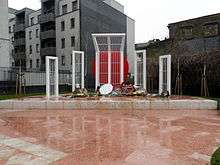
Asian people from a wide range of backgrounds have faced discrimination and racism in the United Kingdom. There have been examples of abuse faced by Asian British people, and their communities, dating from the 1960s up until the 2020s.
Following Enoch Powell's Rivers of Blood speech, and the establishment of the National Front in the late 1960s, the South Asian community in particular faced ongoing racist treatment. This included overt racism in the form of Paki bashing, predominantly from white power skinheads, the National Front, and the British National Party, throughout the 1970s and 1980s.[129] British Asians have been historically subjected to forms of discrimination and racism since significant immigration into the UK during the 20th century.[130] Drawing inspiration from the Indian independence movement, the Black Power movement, and the Anti-Apartheid Movement, young British Asian activists began a number of anti-racist Asian youth movements in the 1970s and 1980s, including the Bradford Youth Movement in 1977, the Battle of Brick Lane following the murder of Altab Ali in 1978, and the Newham Youth Movement following the murder of Akhtar Ali Baig in 1980.[131]
According to the UK's hate crime statistics, during the coronavirus pandemic hate crimes directed at both South and East Asian communities increased between two and three-fold.[132][133][134]
A 2020 YouGov survey found that 61 percent of Asians (under the label "Other Asian") had experienced being called a racial slur in the UK, with British Chinese in particular, self-reporting at 76 percent.[135][136]
LGBT communities
There have been reports and examples of cultural difficulties with tolerance for LGBT people within some Asian British communities. ITV News has reported: "For many in the Asian Community the fear of stigma or rejection from family leads them to hide their true self and in extreme cases turn to alcoholism, drugs and even suicide".[137] In 2014, Nazim Mahmood, a British medical doctor working in Harley Street, commited suicide after being advised to "seek a cure" for his sexuality by his parents. As a result of Mahmood's suicide, the Naz and Matt Foundation was created, as a charity to challenge homophobia caused by religious and cultural beliefs.[138]
In 2017, it was reported how gay Asian Britons were "forced into heterosexual marriages" by cultural and religious pressure.[139] As a result, some were actively finding other gay members of the opposite sex for, what the BBC described as, "marriages of convenience".[140]
In 2018, the BBC reported how British comedy-drama series Ackley Bridge had challenged "the taboo and divisive subject of homosexuality" in British Asian society.[141] The broadcaster also reported how a ComRes survey showed that Asian British people, of all ages, appeared to hold "more socially conservative views on gay relationships".[142] According to a survey by the charity Stonewall, more than 50 percent of Asian Britons who identified as LGBT had faced discrimination.[143]
In 2019, the BBC documented the struggle for gay men to find acceptance in the UK's Punjabi Sikh community.[144] ITV News has reported on similar difficulties for gay Sikhs living in Rochdale.[145] In 2020, British actress Jameela Jamil, describing herself as "queer", stated that "it's not easy within the south Asian community to be accepted".[146]
See also
- British Bangladeshi
- British Indians
- British Pakistanis
- List of British Sikhs
- British Sri Lankans
- British Tamils
- List of British Asian people
- Scottish Asian
- Anglo-Indian
- BBC Asian Network
- British Asians in politics of the United Kingdom
- British Cypriots
- British Indo-Caribbean people
- Foreign-born population of the United Kingdom
- Mauritian diaspora in the United Kingdom
- Nepalese in the United Kingdom
- Non-resident Indian and Person of Indian Origin
- South Asian Canadians
- Sunrise Radio
References
- From the 2011 census, all usual residents of ethnic group Asian or Asian British (Indian, Pakistani, Bangladeshi, Chinese and Other Asian)
- DC2201EW - Ethnic group and religion (Excel sheet 21Kb) ONS. 15 September 2015. Retrieved 14 January 2016.
- "Statistics - release calendar - GOV.UK". Retrieved 18 March 2015.
- "A guide to comparing 1991 and 2001 Census ethnic group data" (PDF). Office for National Statistics. Retrieved 27 April 2015.
- "Ethnic group". Office for National Statistics. 2 November 2011. Retrieved 27 April 2015.
- Fisher, Michael H. (2006). "Introduction". Counterflows to Colonialism: Indian Travellers and Settlers in Britain, 1600–1857. p. 1. ISBN 978-81-7824-154-8.
- Bhopal, Raj (2004). "Glossary of terms relating to ethnicity and race: for reflection and debate". Journal of Epidemiology & Community Health. 58 (6): 441–445. doi:10.1136/jech.2003.013466. PMC 1732794. PMID 15143107.
- "Language and the BSA: Ethnicity & Race". British Sociological Association. March 2005. Archived from the original on 27 April 2015. Retrieved 27 April 2015.
- "A guide to comparing 1991 and 2001 Census ethnic group data" (PDF). Office for National Statistics. Retrieved 27 April 2015.
- Phillips, Tom (14 October 2013). "Fact Check: Is Boris Johnson Right About Harry Potter?". BuzzFeed UK.
Cho Chang is not an "overseas student" at Hogwarts ... JK Rowling never describes her as that. As far as we can tell, she's British-Asian.
- "The next big British Asian boxer?". BBC. 11 February 2014.
With Amir Khan and Prince Naseem there’s a strong boxing pedigree in the British Asian community. So could Ryan Nandha add his name to that list?
- "Harry Potter star Katie Leung hits out after theatre puts on Chinese play with all-white cast for play set in China". The Herald. 23 December 2016.
- Fane Saunders, Tristram (20 January 2017). "Yellowface protest over 'racist' casting at London theatre". The Daily Telegraph. Retrieved 3 June 2020.
- Fane Saunders, Tristram (20 March 2017). "The 'yellowface' row proved British theatre is stuck in the past - but could a new play bring it forward?". The Daily Telegraph.
The play is staged in a Peter Brook-esque empty space, and has a British Asian cast led by 42-year-old actress Lourdes Faberes as the titular warlord.
- Chandler-Wilde, Helen (30 April 2019). "Asian women of achievement: Meet the 14 winners shaping the UK". The Daily Telegraph. Retrieved 3 June 2020.
- Iqbal, Nosheen (27 July 2019). "'We're women with brown skin, talking proudly about sex'". The Guardian. Retrieved 3 June 2020.
- Gallagher, Sophie (2 August 2019). "Brown Girls Do It Too: 7 Things The Sex-Positive Podcasters Want You To Know". HuffPost UK.
British Asian women are deeply flawed too – we make mistakes and do antifeminist things in sex because we think men will like it, we want to present this.
- Flint, Hanna (20 January 2020). "Is it time the all-white period drama was made extinct?". BBC.
It’s one of the reasons why she cast British Asian actor Gemma Chan ... as white historical figures Bess of Hardwick
- Tran, Joanna (21 June 2019). "Gemma Chan doesn't want to be 'the only successful British Asian actress'". Resonate.
And now I just hope it’s going to open the door for others. I don’t want to be the only successful Asian actress or British Asian actress.
- Lee, Michelle (11 November 2019). "The Allure Podcast: Gemma Chan on Aging, Self-Acceptance, and Being a Kid of the '90s". Allure (Podcast). Retrieved 3 June 2020.
- Pithers, Ellie (14 January 2019). "Gemma Chan's Critics' Choice Gown Is Decidedly Dramatic". Vogue. UK.
Gemma Chan: Sandra at Jimmy Choo is British-Asian. I like to support diversity and promote inclusivity in fashion whenever possible.
- Sherwood, Harriet (7 February 2016). "Visit My Mosque day: questions from prayers to beards answered". The Guardian. Retrieved 3 June 2020.
- "2011 Census: Ethnic group, local authorities in the United Kingdom". Office for National Statistics. 11 October 2013. Retrieved 25 April 2015.
- Gardener, David; Connolly, Helen (October 2005). "Who are the 'Other' ethnic groups?" (PDF). Office for National Statistics. Archived from the original (PDF) on 15 February 2006.
- Ballard, Roger, ed. (2007). Desh Pardesh : the South Asian presence in Britain. London: C. Hurst & Co. p. 19. ISBN 978-1-85065-091-1.
- Shaw, Alison (2000). Kinship and Continuity: Pakistani Families in Britain Studies. Routledge. p. 16. ISBN 978-90-5823-075-1.
- Tang, Lynn (2019). Recovery, Mental Health and Inequality: Chinese Ethnic Minorities as Mental Health Service Users. Routledge. ISBN 978-0-367-22443-1.
Between World War II and the 1950s Chinese immigrants were mostly from South East Asia. Hong Kong was a colony of the UK from 1841 to 1997. The late 1950s saw a wave of Chinese immigration to the UK from Hong Kong.
- Wai-kam Yu, Sam (2000). Chinese Older People: A need for Social Inclusion in Two Communities. Policy Press. ISBN 978-1-86134-242-3.
The majority of Chinese immigrants arrived in the UK in two waves. The first took place in the late 1950s. Most were young males coming from rural areas of Hong Kong.
- "Office for National Statistics (ONS) - ONS". Retrieved 18 March 2015.
- "Ethnicity & Identity" (PDF). Focus On. Office for National Statistics. January 2004. p. 12. Archived from the original (PDF) on 22 July 2004. Retrieved 22 July 2004.
- "Ethnicity & Identity" (PDF). Focus On. Office for National Statistics. January 2004. p. 5. Archived from the original (PDF) on 22 July 2004. Retrieved 22 July 2004.
- United Nations High Commissioner for Refugees. "Refworld - World Directory of Minorities and Indigenous Peoples - United Kingdom : South Asians". Refworld. Retrieved 18 March 2015.
- "Overtaking". The Economist.
- "Employment". Gov.uk. October 2019. Retrieved 21 January 2019.
- Gostoli, Ylenia (1 May 2020). "Coronavirus: Filipino front-line workers pay ultimate price in UK". Al Jazeera. Retrieved 21 May 2020.
- "Urdu/Hindi today by Viv Edwards". BBC.co.uk. Retrieved 23 March 2015.
The Urdu community in the UK is very much larger than the Hindi community. Most of those who identify themselves as Urdu speakers use a variety of Panjabi as the language of the home, and speak Urdu as a second language for religious and cultural reasons. The overwhelming majority comes from the west Panjab and the Mirpur district of Azad Kashmir, but smaller groups of Gujarati Muslims from both India and East Africa also use Urdu for religious purposes.
- Schott, Judith; Henley, Alix. Culture, Religion, and Childbearing in a Multiracial Society: A Handbook for Health Professionals. ISBN 978-0-7506-2050-5.
- Hegner, Victoria; Margry, Peter Jan (2017). Spiritualizing the City: Agency and Resilience of the Urban and Urbanesque habitat. Oxford UK: Routledge. pp. 121–123. ISBN 978-1-138-93072-8.
- Lustig, Robin; Bailey, Martin; de Bruxelles, Simon; Mather, Ian (19 February 1989). "War of the Word". The Observer. Retrieved 7 July 2014.
- "1989: Ayatollah sentences author to death". BBC News. 14 February 1989.
- Buckland, C.E. (1968). Dictionary of Indian Biography. Haskell House Publishers Ltd. p. 217.
- Alam, Shahid (12 May 2012). "For casual reader and connoisseur alike". The Daily Star.
- Colebrooke, Thomas Edward (1884). "First Start in Diplomacy". Life of the Honourable Mountstuart Elphinstone. pp. 34–35.
- Fisher, Michael H.; Lahiri, Shompa; Thandi, Shnider (2007). A South Asian History of Britain: Four Centuries of Peoples from the Indian Sub-Continent. Oxford, UK. pp. 6–8. ISBN 978-1-84645-008-2.
- "The Goan community of London - Port communities". portcities.org.uk. Retrieved 23 February 2016.
- Nijhar, Preeti (30 September 2015). Law and Imperialism: Criminality and Constitution in Colonial India and Victorian England. Routledge. ISBN 978-1-317-31600-8.
- "LMA Learning Zone > schooLMAte > Black and Asian Londoners > Timeline". learningzone.cityoflondon.gov.uk. Archived from the original on 7 March 2016. Retrieved 23 February 2016.
- Fisher, Michael H. (2006). Counterflows to Colonialism: Indian Traveller and Settler in Britain, 1600–1857. ISBN 978-81-7824-154-8.
- Fisher, Michael H. (2006). Counterflows to Colonialism: Indian Traveller and Settler in Britain, 1600–1857. Orient Blackswan. pp. 111–9, 129–30, 140, 154–6, 160–8, 172, 181. ISBN 978-81-7824-154-8.
- Fisher, Michael H. (2006). Counterflows to Colonialism: Indian Traveller and Settler in Britain, 1600–1857. p. 1. ISBN 978-81-7824-154-8.
- "Research project: Lascar Lives". southampton.ac.uk. University of Southampton. Retrieved 3 June 2020.
- Fisher, Michael H. (2006). Counterflows to Colonialism: Indian Traveller and Settler in Britain, 1600–1857. Orient Blackswan. pp. 111–9, 129–30, 140, 154–6, 160–8, 181. ISBN 978-81-7824-154-8.CS1 maint: ref=harv (link)
- Fisher, Michael H. (2004). Counterflows to Colonialism: Indian Travellers and Settlers in Britain, 1600–1857. Delhi: Permanent Black. ISBN 978-81-7824-154-8.
- Ansari, Humayun (2004). The Infidel Within: The History of Muslims in Britain, 1800 to the Present. C. Hurst & Co. Publishers. ISBN 978-1-85065-685-2.
- Robinson-Dunn, Diane (February 2003). "Lascar Sailors and English Converts: The Imperial Port and Islam in late 19th-Century England". Seascapes, Littoral Cultures, and Trans-Oceanic Exchanges. Archived from the original on 2 August 2012. Retrieved 13 January 2009.
- Behal, Rana P.; van der Linden, Marcel, eds. (2006). Coolies, Capital and Colonialism: Studies in Indian Labour History. Cambridge: Cambridge University Press. p. 114. ISBN 978-0-521-69974-7.
- Fisher, Michael H. (2006). Counterflows to Colonialism: Indian Traveller and Settler in Britain, 1600–1857. ISBN 978-81-7824-154-8.
- "Curry house founder is honoured". BBC. 29 September 2005. Retrieved 5 July 2014.
- "The Travels of Dean Mahomet". publishing.cdlib.org. Retrieved 24 February 2016.
- Behal, Rana P.; Linden, Marcel van der (1 January 2006). Coolies, Capital and Colonialism: Studies in Indian Labour History. Cambridge University Press. ISBN 978-0-521-69974-7.
- "Strangers' Home for Asiatics, Africans and South Sea Islanders | Making Britain". open.ac.uk. Retrieved 23 February 2016.
- Chatterji, Joya; Washbrook, David (3 January 2014). Routledge Handbook of the South Asian Diaspora. Routledge. ISBN 978-1-136-01824-4.
- Visram, Rozina (2002). Asians In Britain: 400 Years of History. pp. 254–269.
- Behal, Rana P.; Linden, Marcel van der (2006). Coolies, Capital and Colonialism: Studies in Indian Labour History. ISBN 978-0-521-69974-7.
- Jones, J. P. (February 1931). "Lascars in the Port of London". The P.L.A. Monthly. Retrieved 3 June 2020 – via lascars.co.uk.
- Visram, Rozina (30 July 2015). Ayahs, Lascars and Princes: The Story of Indians in Britain 1700–1947. Routledge. ISBN 978-1-317-41533-6.
- Panayi, Panikos (11 September 2014). An Immigration History of Britain: Multicultural Racism Since 1800. Routledge. ISBN 978-1-317-86423-3.
- Ahmed, Giasuddin (7 January 2017). Aftab Ali: The Hero of Indian Seamen. CreateSpace Independent Publishing Platform.
- Ullah, Ansar Ahmed (2010). Bengalis in London's East End (PDF).
- Pereira, Clifford (2011). "Goans of the North Atlantic: A Transnational Study of Migration, Technology Adaptation, and Neoculturation across Six Generations". In German, Myna; Banerjee, Padmini (eds.). Migration, Technology and Transculturation: A Global Perspective. St. Charles, Missouri. pp. 174–176. ISBN 978-0-9846307-4-5.
- Frederick, Candice (8 May 2019). "'They Don't Know Me': The Joy Luck Club's Tsai Chin Looks Back on Her 6-Decade Career". New York.
The classically trained Chinese-born British actress, who's had a stellar six-decade career on stage and screen ... her most iconic film roles — including the unwavering Lindo Jong in The Joy Luck Club, the steely Auntie in Memoirs of a Geisha, and the beguiling Bond Girl, Ling, in You Only Live Twice — continue to resonate with audiences
- "New Year Honours for Lennox, Suchet, Hancock and Webb". BBC News. 31 December 2010.
Burt Kwouk, 80, is named an OBE. He is best known as martial arts expert Cato from the Pink Panther movies but more recently starred in Last of the Summer Wine and Channel 4 comedy betting show Banzai!
- "Awards for Ben Kingsley". Internet Movie Database. Retrieved 25 January 2009.
- "Awards for Dev Patel". Internet Movie Database. Retrieved 4 January 2009.
- Kroll, Justin (5 August 2019). "Gemma Chan in Talks to Join Marvel's 'The Eternals'". Variety.
Earlier this year, Chan portrayed Minn-Erva in "Captain Marvel," but its unknown if she will be playing the same role in "The Eternals." Some sources have indicated that her part in "The Eternals" would be a completely different role, which if true, would mark one of the first times a star will have played two different characters in the same cinematic universe.
- Anderton, Joe (16 April 2020). "Avengers: Endgame star makes surprise appearance in season 2 premiere of What We Do In The Shadows". Digital Spy.
The season 2 premiere, Resurrection, featured a guest appearance from one of the Marvel Cinematic Universe's funniest stars, Benedict Wong. You'll know him as Doctor Strange's buddy, Wong.
- Godfrey, Alex (23 July 2016). "Riz Ahmed: 'You don't need to tell me we live in scary times. I'm Muslim'". The Guardian. Retrieved 3 June 2020.
- Lynch, John (20 March 2018). "The 23 most successful movie franchises of all time". Business Insider. Retrieved 3 June 2020.
- Safi, Michael (6 August 2018). "Photographer charged as police crackdown in Bangladesh intensifies". The Guardian. Retrieved 8 August 2018.
- Pasha, Syed Nahas (17 November 2011). "Bangladeshi designs London Olympic coin". Bdnews24.com. Archived from the original on 19 November 2011. Retrieved 1 December 2012.
- Kumar, Pravesh (13 January 2015). "Rifco theatre company chief: 'diversity does not always mean cost'". The Guardian (Interview). Interviewed by Matthew Caines. Retrieved 3 June 2020.
- Fitzpatrick, Liam (2006). "Farrokh Bulsara". Time Asia. Archived from the original on 11 December 2006.
- "Music Video: "One More Dance" by Mumzy Stranger". MTV Iggy. 28 May 2009. Archived from the original on 31 May 2009. Retrieved 18 June 2009.
- Johnson, Billy, Jr. (8 October 2009). "Jay Sean: American Boy". Yahoo! Music. Archived from the original on 12 October 2009.
- "Searchable Database". Recording Industry Association of America. Archived from the original on 26 June 2007. Retrieved 21 June 2011.
- Akbar, Arifa (30 October 2009). "After 2,000 gigs, Hounslow singer tops the US charts". The Independent. Retrieved 30 October 2009.
- "Jay Sean's the Urban US legend". Daily Mirror. 10 October 2009. Retrieved 30 September 2009.
- Youngs, Ian (23 September 2009). "British R&B star conquers America". BBC News. Retrieved 8 October 2009.
- "Amar Koomz: from Brixton to the big time". BBC London. 15 August 2018. Retrieved 20 September 2018 – via YouTube.
- Kalia, Ammar (11 January 2019). "The birth of Asian underground: 'This music was for us and by us, and that was very powerful'". The Guardian. Retrieved 3 June 2020.
- "Hillingdon inter-faith campaigner made MBE in New Year Honours". Hillingdon Times. Retrieved 10 October 2018.
- "Saif Ahmad Joins Al-Khair Foundation as CEO". Al Khair Foundation. 19 May 2015. Archived from the original on 22 December 2015. Retrieved 1 January 2016.
- "Governance Report 2010 -2011" (PDF). LPFA Governance Report: 5. 2010. Retrieved 1 July 2018.
- "Sunderland 1-4 Newcastle". BBC Sport. bbc.co.uk. 17 April 2006. Retrieved 24 March 2008.
- "British Asians in Sport and Physical Activity Summit to get underway at Edgbaston". Sky Sports. 22 November 2018. Retrieved 23 March 2019.
- Hussain, Abid (6 July 1999). "Rediff On The NeT: Hussain makes history". rediff.com. Retrieved 23 March 2019.
- "Live Cricket Scores & News International Cricket Council". icc-cricket.com. Retrieved 23 March 2019.
- "Talking dog's top YouTube hit". Sky News. 20 December 2011. Archived from the original on 21 September 2013. Retrieved 1 February 2013.
- Hawkins, Si (24 August 2013). "Diary of a funny man: the comedian Humza Arshad on love and hate on the web". The National. Abu Dhabi. Retrieved 10 October 2013.
- "British Asians Today: A Statistical Overview" (PDF). Centre for Social Markets. July 2001. p. 1. Retrieved 20 January 2019.
- Laud, Derek (2015). The Problem with Immigrants. Biteback Publishing. ISBN 978-1-84954-877-9. Retrieved 5 March 2015.
- Ramachandaran, Shastri (14 July 2014). "India has much to learn from Britain and Germany". Daily News and Analysis. Retrieved 22 October 2015.
Britain places high value on the power of commerce. After all, its political and military dominance when Britannia ruled the waves was founded on its trading power. The Gujaratis know this better than many others, which explains their prosperity and success in the UK.
- Benton, Gregor (2007). "The Chinese Economy in Britain". The Chinese in Britain, 1800–Present: Economy, Transnationalism, Identity. Palgrave Macmillan. p. 115. ISBN 978-0-230-52229-9.
A second wave of Chinese entered the fish-and-chip trade ... British-style fish-and-chip shops, whose original menus it supplemented (or, less commonly, supplanted) with Chinese dishes ... The chip shop was an ideal investment for the would-be takeaway owner or restauranteur and remained a target of Chinese immigrants for the rest of the century.
- Sam Wai-kam Yu (2000). "Chinese people's survival strategy in the UK". Chinese Older People: A Need for Social Inclusion in Two Communities. Policy Press. p. 4. ISBN 978-1-86134-242-3.
As fewer Chinese seamen came to the UK; people shifted to laundry servies - in 1931 there were over 500 Chinese laundries in the UK ... In response to the decline in demand for laundry services, they started to work in the Chinese restaurant business and run Chinese take-aways, which had a fast growth in the 1960s.
- Ward, Robin (2010). "Small entrepreneurs in contemporary Europe". Ethnic Communities in Business: Strategies for Economic Survival. Cambridge University Press. p. 35. ISBN 978-0-521-12969-5.
For example, Chinese in the Midlands and North-West in Britain have taken over much of the traditional British fish and chips business. The Chinese work longer hours and offer a wider variety of food than their British competitors.
- Unnithan, Chitra (23 May 2012). "Family is key to success of Gujarati businessmen in Britain". The Times of India. Times News Network. Retrieved 4 February 2015.
British Gujaratis were also more successful than other minority communities in Britain because they had already tasted success in Africa. The book also says that Gujarati Hindus have become notably successful public citizens of contemporary, capitalistic Britain; on the other hand, they maintain close family links with India. "British Gujaratis have been successful in a great variety of fields. Many younger Gujaratis took to professions rather than stay behind the counter of their parents' corner shops, or they entered public life, while those who went into business have not remained in some narrow commercial niche," says the book.
- Sen, Sudeshna (8 January 2013). "How Gujaratis changed corner shop biz in UK". The Economic Times. Retrieved 4 February 2015.
"What most people don't get is that those who took the Arab dhows in the 17th and 18th century to leave their villages and set up life in an alien land were already an entrepreneurial and driven minority, in search of a better life. They communicated that hunger to their children," says Raxa Mehta, director at Nomura, based in Tokyo and first generation child of Kenyan Indian parents. So it doesn't surprise the Gujaratis that they did well in Britain – it only surprises the Brits and Indians. The Gujaratis are a trader community. As Manubhai says, they always left the fighting to the others. If there's one diaspora community that East African Asians model themselves on, it's the Jews. Except of course, the Jews get more publicity than they do.
- Rodger, Richard; Herbert, Joanna (2008). "Narratives of South Asian women in Leicester 1964 - 2004" (PDF). Oral History. 36 (2): 554–563.
- "Housing: Sikhs most likely to own their own homes". Religion. UK National Statistics. 11 October 2004. Archived from the original on 26 February 2008. Retrieved 4 April 2008.
- "The World's Most Powerful People". Forbes. Retrieved 21 March 2015.
- "Rich List 2019: the UK's richest Asians". The Sunday Times. 12 May 2019. Retrieved 3 June 2020.
- Brinded, Lianna (13 May 2019). "Asians most heavily represented ethnic minority in UK rich list". Yahoo! News.
David and Simon Reuben also rank second in the overall richest people in Britain list as well as richest Asians in Britain list with a net worth of £18.664bn.
- Lindsay, Robert. "Anecdotes of an Indian life: Chapter VII". Lives of the Lindsays, or, A memoir of the House of Crawford and Balcarres. National Library of Scotland. 4.
- Al-Mahmood, Syed Zain (19 December 2008). "Down the Surma - Origins of the Diaspora". The Daily Star. 7 (49). Retrieved 1 May 2019.
- Visram, Rozina (1986). Ayahs, Lascars and Princes. Pluto Press.
- Adams, Caroline (1987). Across Seven Seas and Thirteen Rivers. London.
- Hossain, Ashfaque (November 2014). "The world of the Sylheti seamen in the Age of Empire, from the late eighteenth century to 1947". Journal of Global History. 9 (3). doi:10.1017/S1740022814000199.
- "Welcome". Indian International Chef of the Year. Retrieved 24 May 2009.
- "Curry industry supremo is awarded MBE". Manchester Evening News. 18 April 2010. Retrieved 11 April 2011.
- Dixon, Martha (18 September 2003). "Bhangra fusion gathers support". BBC. Retrieved 3 June 2020.
- Hyder, Rehan (2004). Brimful of Asia: Negotiating Ethnicity on the UK Music Scene. ISBN 978-0-7546-0677-2.
- Sharma, Sanjay (1996). "Noisy Asians or 'Asian Noise'?". In Sharma, Sanjay; Hutnyk, John; Sharma, Ashwani (eds.). In Dis-Orienting Rhythms: The Politics of the New Asian Dance Music. London: Zed Books. pp. 32–57.
- Hameed, Ayisha (26 August 2014). "MSS interview with Islah Abdur – Rahman". MyStudentStyle. Archived from the original on 1 February 2015. Retrieved 1 February 2015.
- Kalia, Ammar; Seale, Jack; Catterall, Ali; Jones, Ellen E; Howlett, Paul (26 February 2020). "TV tonight: an intimate look at life for Britain's Bengali families". The Guardian. Retrieved 3 June 2020.
- Baddhan, Raj (4 September 2017). "Women dominate Asian Achievers Awards 2017". BizAsia. Retrieved 8 September 2018.
- Minter, Harriet; O'Conor, Lottie (20 May 2015). "Asian women of achievement awards 2015: meet the winners". The Guardian. Retrieved 8 September 2018.
- Rayner, Jonathan (14 May 2010). "Asian lawyers recognised in awards". The Law Society Gazette. Retrieved 8 September 2018.
- Sethi, Sonika (29 April 2018). "Asian Awards 2018: Recognition with Lots of Glitz and Glamour". DESIblitz. Retrieved 8 September 2018.
- Dubb, Amarjit (12 November 2014). "Asian Professional Awards 2014 Nominee Shortlist". DESIblitz. Retrieved 8 September 2018.
- Kabir, Nahid Afrose (2012). Young British Muslims: Identity, Culture, Politics and the Media. Edinburgh University Press. ISBN 978-0-7486-4653-1.
- Thapar, Ciaran (27 January 2020). "Britain, racism and the 'P-word': a GQ special report". GQ. Retrieved 3 June 2020.
Among many British Asians, the "P-word" is thought of as the pinnacle of language which restricted the lives of our parents and grandparents in the latter half of the 20th century.
- Peace, Timothy (2015). European Social Movements and Muslim Activism: Another World but with Whom?. Springer Science+Business Media. p. 55.
- Jamie Grierson (13 May 2020). "Anti-Asian hate crimes up 21% in UK during coronavirus crisis". The Guardian.
Hate crime directed at south and east Asian communities has increased by 21% during the coronavirus crisis, ministers have told MPs.
- Holly Chant (8 July 2020). "Increase in hate crime against Asian communities leads volunteer to launch anti-racism campaign". Hackney Gazette.
Newham resident Alvin Carpio set up the campaign after official figures revealed a three-fold increase in hate crime directed at south and east Asian communities during the coronavirus crisis.
- "Victim of racial abuse was told 'you guys are the virus' as hate crimes against east Asian community soar". ITV News. 11 June 2020.
The government says it “strongly condemns those who have directed hate crime towards members of the East and South East Asian communities.
- James Morris (28 July 2020). "'It's vicious': What it's like living through the UK's coronavirus racism". Yahoo News.
This was happening before the pandemic, of course. YouGov polling last month found 76% of Chinese people (and 61% of other Asians) in the UK have experienced someone saying a racial slur to them. Some 50% of the Chinese respondents said it’s happened multiple times.
- "YouGov Racism BAME June 2020" (PDF). YouGov. June 2020.
- "From the North: The challenges facing Asians in the LGBT+ community". ITV News. 30 June 2020.
- Nomia Iqbal; Josh Parry (30 July 2019). "LGBT people are 'being made homeless due to religion'". BBC.
- Sima Kotecha (19 July 2017). "Gay British Asians being 'forced into heterosexual marriages'". BBC.
Twenty-two gay and lesbian people of South Asian heritage have told the BBC that at some point they were pressurised to marry somebody of the opposite sex.
- "LGBT Asians turning to marriages of convenience". BBC. 8 November 2017.
- "Is homosexuality still taboo in British Asian families?". BBC. 12 August 2018.
Is what we see on TV the real story of being gay in British Asian society? Three generations of families give their own take on the taboo and divisive subject of homosexuality - which was recently addressed in the drama series Ackley Bridge.
- "British Asians more socially conservative than rest of UK, survey suggests". BBC. 13 August 2018.
When they ended up staying so did those values which many passed to their British-born children. This is perhaps why the survey suggests that the British Asian community has more socially conservative views on gay relationships and sex before marriage, even amongst the younger generation.
- Krishna Khakhria (28 July 2018). "Hungama: The club celebrating London's LGBT South Asians". BBC.
Last month, a report by Stonewall revealed that more than half of black, Asian and minority ethnic people have faced discrimination in the LGBT community.
- Minreet Kaur (19 December 2019). "A gay man's struggle for acceptance in the Sikh community". BBC.
- Minreet Kaur (28 February 2020). "A powerful account of being gay in the Asian community". ITV News.
- Ben Hunte (6 February 2020). "Jameela Jamil announces she is 'queer' after backlash over TV role". BBC.
That prompted her to issue a statement addressing her sexuality. Opening with "Twitter is brutal", she explained that she identified "as queer" and had previously struggled to discuss the topic because "it's not easy within the south Asian community to be accepted".
External links
- The Asian Post UK, The Voice of British Asians - Weekly Newspaper - News, Sports, Business, Opinion, Features, Entertainment, News in Pictures, Breaking News
- BBC Radio Player discussion on the dissatisfaction over the term Asian
- hWeb – An outline of the immigration pattern of the Pakistani community in Britain
- British Council Arts – Contemporary Writers information on British Asian writer Raman Mundair.
- BBC News Many Asians 'do not feel British' 30 July 2007 based on ICM Research poll conducted 4–12 July 2007
- London Asian Guide – Online Guide for British Asians
- Reassessing what we collect website – The Asian Community in London History of Asian London with objects and images
- Asians UK, British Asians, Events and PR, Engaging the British Asians in the UK, Ehan Rajah, Shazana Rajah
- British Asian Magazine – News, Features, Lifestyle & Entertainment